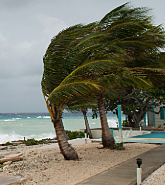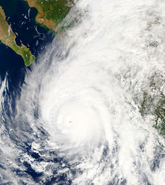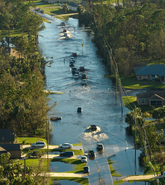There is a strong consensus for an above-average 2024 North Atlantic hurricane season according to the latest seasonal tropical cyclone forecasts issued by numerous meteorological agencies and groups, with some forecasters not ruling out a hyperactive season.
June 1 heralded the official start of the 2024 North Atlantic hurricane season, and Moody’s RMS Event Response has recently issued an Executive Summary of Moody’s RMS Event Response 2024 Northern Hemisphere Tropical Cyclone Outlook report, click here to download.
This executive summary includes a review of North Atlantic and Western North Pacific seasonal forecasts for 2024 and a look at the key oceanic and meteorological drivers of those forecasts.
For a detailed analysis, Moody’s RMS Event Response customers can access the 36-page report on the Support Center, but in this blog, we will provide an overview and look at what might be in store this year.
North Atlantic Forecasts
The U.S. National Oceanic and Atmospheric Administration (NOAA) has forecast 17 to 25 named storms, eight to 13 are expected to become hurricanes, and of these, four to seven are expected to become major hurricanes (Category 3 or stronger).
The Accumulated Cyclone Energy (ACE) index—a cumulative measure of the overall duration and intensity of storms in the basin—is expected to range between 145 and 237.
The predicted storm activity ranges for 2024 are centered well above NOAA’s 1991–2020 U.S. Climate Normals seasonal average of 14 named storms, seven hurricanes, and three major hurricanes. The 1951–2020 median ACE index value is 96.7.
The outlooks from the majority of the other meteorological forecast agencies and groups—including Colorado State University, Tropical Storm Risk, the U.K. Met Office, the European Centre for Medium-Range Weather Forecasts, and Mexico’s Servicio Meteorológico Nacional—are broadly in line with the guidance issued by NOAA in calling for a season that is above-average with a possibility of a hyperactive season.
It is worth remembering that climatologically, tropical cyclone activity in the North Atlantic Basin peaks between mid-August and late October. Most forecast groups will issue a revised forecast in early August to reflect the increased certainty in the meteorological and oceanic variables—look out for an updated blog from us in August.
So, what are the major factors driving hurricane risk for this season?
ENSO and North Atlantic SSTs
The forecasts reflect the combined influence of several key seasonal oceanic and atmospheric factors that typically influence intraseasonal hurricane activity in the North Atlantic, primarily North Atlantic sea surface temperatures (SSTs) and the El Niño-Southern Oscillation (ENSO).
Much of the uncertainty associated with seasonal hurricane activity forecasts can be attributed to the subsequent uncertainty about which El Niño-Southern Oscillation (ENSO) phase will materialize during the peak months of the hurricane season during August, September, and October. As of June 2024, ENSO-neutral conditions are observed in the Pacific Ocean.
According to probabilistic forecasts compiled by the Climate Prediction Center, there is a 77 percent chance of La Niña conditions through the peak months of the hurricane season (August to October) and a greater than 80 percent chance of La Niña conditions persisting into the Northern Hemisphere winter.
La Niña conditions in the equatorial Pacific Ocean typically lead to weaker upper-level westerly winds and weaker lower-level easterly trade winds across the North Atlantic Basin. This reduces vertical wind shear and increases atmospheric instability, which encourages hurricane formation, development, and intensification.
Without the influence of any other factors, activity would be expected to be above normal. The forecast emergence of La Niña conditions is further supported by a forecast weakening of vertical wind shear anomalies and weaker-than-normal trade winds, both of which facilitate tropical activity.
Warmer sea surface temperatures (SSTs) typically enhance tropical cyclone activity by providing increased energy and moisture to the environment. SSTs in the main development region of the tropical North Atlantic are nearly at a record high for the time of year with an area-averaged temperature anomaly of approximately +1.22° Celsius.
Many areas are forecast to experience anomalies of +0.55° Celsius to +1.05° Celsius between August and October 2024 covering the peak months of the hurricane season.
This warmth also supports the notion that the Atlantic Multidecadal Oscillation (AMO) and Atlantic Multidecadal Variability (AMV) are currently in a positive (warm) phase, which is representative of a high-activity era. Warmer sea surface temperatures and a positive phase typically enhance tropical activity by providing increased energy and moisture to the environment.
The combination of these factors has resulted in the overall forecast for an above-average season in 2024. Other factors, such as the North Atlantic Oscillation (NAO), the Madden-Julian Oscillation (MJO), and the Saharan Air Layer (SAL), can influence tropical cyclone activity on a weekly or monthly basis but are difficult to forecast at seasonal timescales.
Western North Pacific Forecasts
In the Western North Pacific, forecasts indicate a slightly below-average to near-average year in the basin in 2024. The La Niña conditions in the equatorial Pacific Ocean and the associated anomalous Walker circulation typically lead to stronger trade winds in the Western North Pacific.
This generally results in stronger easterly trade winds, increasing vertical wind shear, and a decrease in atmospheric instability in the region, typically inhibiting cyclogenesis and intensification, often resulting in a slightly less active year.
La Niña years also see the Southeast Asia monsoon trough typically retreating westward and the subtropical ridge strengthening, shifting the main cyclogenesis region westward toward the Philippines and the South China Sea.
Sea surface temperatures across the Western North Pacific Basin are expected to be above average between July and November 2024. Warmer SSTs typically enhance tropical activity by providing increased energy and moisture to the environment.
The Pacific Decadal Oscillation (PDO), a long-lived ENSO-like pattern of climate variability that alternates approximately every 20 to 30 years between warm and cool phases, has generally been in a negative phase since around 2020, meaning activity has generally decreased compared to the average. This phase is expected to continue through 2024.
A Trusted Partner
Although only time will tell what unfolds this season, Moody’s RMS Event Response and the (re)insurance industry are not strangers to active hurricane seasons. Seven of the last eight seasons (2016–23) were classified as above normal, two were designated as extremely active (2017 and 2020).
Whatever the final storm count is in 2024, we remain committed to supporting our customers during active hurricane events. Last year, with Hurricane Idalia we marked our fastest reaction time to a landfalling major U.S. hurricane.
Five days after Idalia’s landfall we released our industry loss estimate and associated suite of optimized post-landfall wind and storm surge modeling and accumulation information.
This is a testament to our event response workflow process enhancements and innovations over the last few years that have helped improve efficiency and reduce delivery timelines.
We continue to work diligently to build on our recent advancements and provide our customers with faster and more comprehensive analytics. For instance, the Moody’s ExposureIQ™ application on Moody’s Intelligent Risk Platform™ now puts Event Response and HWind insights into our customer's hands like never before, with around-the-clock automated updates.
As a trusted partner, our Event Response team is again ready to inform your critical business processes with reliable information during the year’s most impactful events.
The Moody’s RMS Event Response team ensures clients are well informed of global tropical cyclone activity with regular updates on the Support Center. Follow Moody’s RMS social media channels on X/Twitter and LinkedIn for updates.
Download the Moody’s RMS Event Response 2024 Northern Hemisphere Tropical Cyclone Outlook Executive Summary here. Moody’s RMS Event Response customers can view the full 36-page report on the Support Center.










